Surviving in extreme weather, taiga animals are few and far between. While there are summers here, they are shorter and cooler than summers in other places.
Taiga is also known as boreal forests or snow forests due to the long cold and snow-packed winters here.
Taigas are spread around the Northern part of The Northern Hemisphere. There’s a North American taiga, a Scandinavian taiga, and an Asian taiga where a few and sometimes a similar number of animals live.
Table of Contents
What is a Taiga
Taigas are dense boreal forests with coniferous trees specific to Northern latitudes. This biome is often described as an intermediary between the tundra and steppes. Pine forests, spruce forests, and larch forests all make up the boreal forests and what is considered the largest biome in the world.
Taigas are found in North America, from Alaska to the Northern parts of Canada. They are also found in Europe, mainly in the Scandinavian countries plus the Northern parts of Scotland and Iceland. Taigas are further found in Northern Russia, Japan, Mongolia, and Kazakhstan.

Insects of the Taiga
A small number of insects can survive the harsh conditions of the taiga as follows.
1. Mosquitoes

Mosquitoes love humidity and they need it to survive and reproduce. The permafrost climate of the taiga plus the wetlands of these dense forests are ideal breeding spaces for mosquitoes.
Many mosquitoes found here feed on animals of the taiga. By some studies, mosquitoes here only feed on birds and frogs.
While they can spread disease, mosquitoes of the taiga may not easily find humans to sting here.
There are also several species of mosquitoes in the biome.
More than 30 species of mosquitoes are identified in the Alaska taiga alone.
Mosquitoes, and other insects, are also important food for other species of the taiga, such as fish, which are largely dependent on them to survive.
2. Ants

Ants are present at least in several species across the world taigas. They can be aggressive or non-aggressive, ground-dwelling, or found on trees.
On study which collected ants in The Scandinavian taiga showed that Red Wood Ants (Formica rufa) are the dominant species of these coniferous woodlands.
These ants live in highly numerous colonies and show aggressive behavior that often displaces ants of other species.
They build large mounds up to several feet high and live in colonies that can easily number more than 100.000 ants.
Red Wood Ants of the taiga are known to use local materials such as pine needles and dry grass to build their mounds.
Another aggressive species found in the taiga is The Blood-Red Ant (Formica sanguinea). This species raids the nest of other ants, kills the queen, and turns the local worker ants into slaves.
3. Beetles

Beetles are one of the troublesome species of the taiga, particularly for the dominant coniferous trees here.
Many species of beetles live in the taiga. Among them, there’s the aggressive Bark Beetle (Curculionidae sp.).
This is a beetle that lives under the bark of spruce, slowly killing its host trees.
The impact of these beetles can be vast. It’s not uncommon for entire spruce forest areas to be killed by what is known as a Bark beetle outbreak.
4. Bees

Bees are often adapted to living in the taiga, although to a lesser extent than in warmer areas.
While there aren’t as many bees here, there are still a few that are well-adapted to cold climates.
Green-blue Bees (Osmia Tersula) are among the species of The Canadian Taiga.
Native to this region, this bee is just half a size of a regular honey bee but it has a hairy body which helps it stay warm.
It lives in cavities or in the ground, typically alone.
This bee doesn’t sting and visits many plants per day which has even prompted it as a chosen species for greenhouse pollination in some of the cooler parts of the country.
A species that also shows adaptability, this bee is present across the taiga and outside the taiga from Alaska to Michigan.
Birds in The Taiga
Often easier to spot, birds are prevalent in boreal forests and in the treeless areas of the taiga.
5. Golden Eagle

Often seen as the most widespread eagle in the world, The Golden Eagle (Aquila chrysaetos) is sometimes seen in the taiga.
Its presence is signaled both in the Eurasian taiga and in the Canadian taiga.
This type of predator lives in diverse climates, mainly in the coniferous areas of the taiga and in the rare birch areas of the Scandinavian taiga.
Much of its flights are specific to mornings and evenings when the Golden Eagle is out looking for food.
Different taiga animals are all part of its daily diet. The eagle feeds on hares and rabbits. It also catches squirrels and rodents.
The long wingspan of the species often places Golden Eagles on top of best flying eagles, and birds in general.
6. Rough-legged Buzzard
A species common in the taiga and up to Arctic habitats, Rough-legged Buzzards (Buteo lagopus) are mostly brown.
Living in all taigas of the world, The Rough-legged Buzzard is a species that feeds on rodents and mammals.
Lemmings and voles are among its favorites.
Rough-legged Buzzards can be further categorized by the area they live in.
This includes the North American subspecies which lives in the taiga to overwinter further South. There are 2 other subspecies in Europe and from Siberia to The Pacific.
These 2 other subspecies also migrate Southwards to overwinter from their typical summertime taiga areas.
7. Steller’s Sea Eagle

This species of eagle (Haliaeetus pelagicus) is native to coastal areas of East Asian taiga in regions of Russia, Korea, and Japan.
As a type of sea bird, Stellerțs Sea Eagles are adapted to eating marine life, specifically fish.
More typical fish species this sea eagles eat include Alaska pollock.
While short, their toes are strong and help them grip fish right out of the water.
This is a species that may retreat to the territorial waters of Japan to overwinter.
On occasion, it may also make its appearance in Alaska, but it’s not established here.
8. Great Gray Owl

Great Gray Owls (Strix nebulosa) live both in the taiga and in warmer areas.
These types of predators are more common in cool climates, on the other hand.
It represents a species that can repurpose old bird nests as Great Gray Owls never build their own nests.
These types of owls prefer the nests of eagles as they are larger and easier to lay eggs in.
Great Gray Owls also show excellent hearing. This is a species that relies on its top acuity to locate pre.
During the winter, the owl can even locate and catch rodents moving about under inches of snow, all due to its above-average hearing capacity.
This owl can be seen both in the dense taiga forest and on the forest edges next to marshes.
9. Snowy Owl

A larger species of owl, The Snowy Owl (Bubo scandiacus) is also a species that lives in the taiga and further North, in some of the coolest climates of the world.
Dominated by white plumage, Snowy Owls also feed on lemmings, voles, and other rodents.
Breeding in the summer, Snowy Owls move into open areas of the taiga to breed.
Male owls start to signal the ideal presence of a nesting site to females.
Snowy Owls are also some of the longest-living birds of the taiga. In extreme cases, these owls can even survive up to 30 years.
Reptiles and Amphibians in The Taiga
Often food for predators or even predators themselves, reptiles and amphibians are also found in the taiga.
10. Red-sided Garter Snake

Mostly black, the Red-sided Gartner Snake (Thamnophis sirtalis parietalis) is known for its rows of red spots that inspire its name.
This species of striped snake also shows additional yellow stripes along its body.
Red-sided Gartner Snakes can live in dense forests, rocky areas, as well as around wetlands.
These are all places where the short snake is spotted in the summer but taiga Red-sided Garter Snakes are absent in the winter as they hibernate.
While it doesn’t live as long as some of the owls in the taiga, a Red-sided Garter Snake can still live up to 20 years.
11. Common European Adder
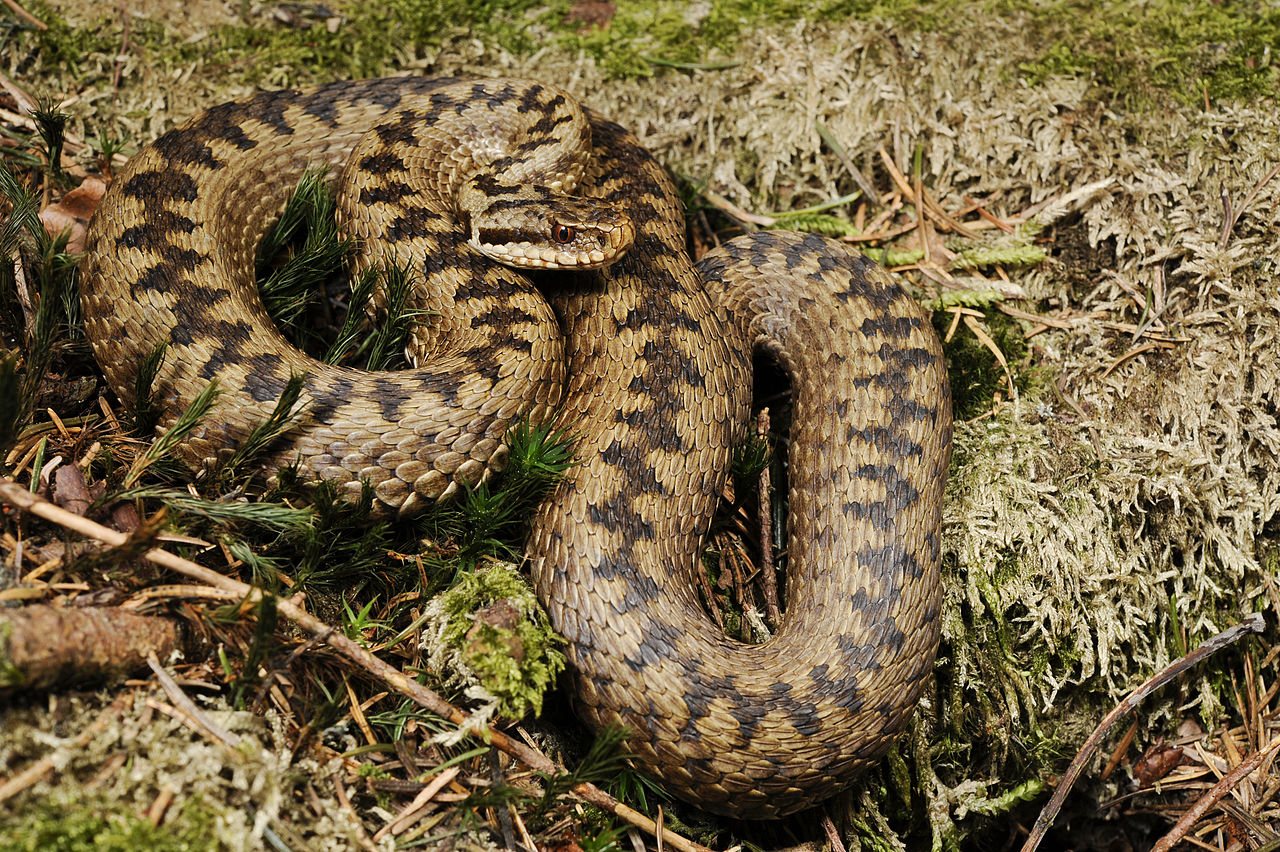
Widespread throughout much of Europe and Asia, The Common European Adder (Vipera berus) is a species that also lives in the taiga.
This is a species of venomous snakes that are highly common in inhabited areas as well.
Well-researched given they often bite humans, these types of venomous snakes may show slightly different traits in the taiga as opposed to other Eurasian biomes they inhabit.
For example, Common European Adders are diurnal in the taiga while nocturnal elsewhere.
Voles and other types of rodents are all part of its diet.
Common European Adders can also live in alpine areas where they eat alpine lizards South of their taiga range.
12. Blue-spotted Salamander

Blue-spotted Salamanders (Ambystoma laterale) are specific to the Eastern Canadian taiga.
This is a species known for its impact on local species as prey. Blue-spotted Salamander is a fan of summertime water accumulations next to boreal forests.
They can also live in the woodlands close to the water in the taiga.
A dark green to black species, The Blue-spotted Salamander is a species that shows multiple blue spots along its body.
Some of its morphs are completely black with additional blue spots along the dorsum and the sides.
These types of salamander grow to an average size of 3.5-4 inches, but can be larger.
13. Northern Two-lined Salamander

Northern Two-lined Salamander (Eurycea bislineata) shares their habitat with Blue-spotted Salamander as both live in territories of Eastern Canada taiga as well as outside of the taiga.
They live in forests, rocky areas, around water, and in wetlands.
Highly territorial, these types of salamanders may also come in conflict with other types of local salamanders.
Its yellow stripes inspire its name. This is a striped salamander with yellow stripes running along its dorsum, up to the mid-tail as the tip of the tail is yellow.
Yellow-brown stripes are also seen on the species that show a black ground color.
14. Wood Frog

Wood Frogs (Lithobates sylvaticus) are found all around The North American Taiga.
They show exceptional adaptation capacity as these frogs can even survive freezing temperatures.
In fact, all of their organs freeze during the winter for the species to snap back to life in the spring.
This is a state of dormancy that is limited by the amount of water comprising their body that can freeze.
As with all frogs, Wood Frogs like water, marshes, and partial water accumulations.
In the taiga, this is a species that can be found in temporary wetlands.
While well adapted to the taiga in Northern Canada, Wood Frogs are even a common sight in different Northeastern habitats of The United States.
15. Northern Leopard Frog

A species native to North America, Northern Leopard Frogs (Lithobates pipiens) are well adapted even to living at high altitudes.
This species prefers marshes and ephemeral and permanent pools where they can lay eggs directly in water.
Northern Leopard frogs are further known to live in grassy areas once their breeding season is over.
While they can lay thousands of eggs in the breeding season, it’s believed the number of Northern Leopard Frogs is in decline.
It’s expected for the decline to be faster outside of the taiga where fish species are introduced to permanent bodies of water.
16. American Toad

Highly common and one of the largest toads of the boreal forests, American Toads (Anaxyrus americanus) are found in the Eastern parts of Canada, up to the taiga.
While large, this is a species that may not be easily spotted due to its solitary nature.
American Toads, like other toads, are mostly seen together in the breeding season and prefer to live and hide on their own for the rest of the year.
Almost permanent bodies of water attract these types of frogs in these dense forests. They gather here for breeding but may live further out on their own outside of the breeding season.
Since the winters are long here, American Toads enter hibernation and can’t be seen up until spring.
17. Canadian Toad

These types of toads grow to a size of just over 2 inches.
Largely absent from their area, Canadian Toads (Anaxyrus hemiophrys) are known for hibernating throughout most of the year.
The toads enter hibernation in August, together with a few other early hibernating species of the taiga.
While they enter hibernation soon, they also come out of hibernation as early as they can, soon after there are no more freezing temperatures.
Toads of the species feed on the various insects they can find here. These insects include ants in the forests as well as flies or bees.
Mammals of The Taiga
Small and large mammals live exclusively or partly in the taiga.
18. Moose

The taiga of North America and Eurasia is home to the moose, a species that only rarely is seen in other Northern Hemisphere forests outside boreal forests.
Mooses (Alces alces) are the largest type of deer and impress with their size.
Much of their days are spent looking for edible vegetation as these large animals need plenty of food given their size.
Simple grasses may not be their preferred choice. They like wildflowers and fresh tree shoots more.
While large, a moose will not tackle deep snow even if it can theoretically make its way through it.
This is a place of vulnerability and moose in front of predators such as wolves typically bring them to safer areas of the taiga where they can hide or make a quicker escape.
19. Caribou

Caribou (Rangifer tarandus) are also known as reindeer and can be one of the most representative mammals of the taiga.
The taiga itself can be harsh on caribou but these are adaptable Northern Hemisphere deer.
One example of the adaptation of the mammal is the female’s weight gain in the summer. The increased body mass helps them during the breeding season.
Males do not get as much or almost no extra weight in the summer, as females.
Caribou are also adaptable when it comes to the feeding options of the winter.
Newborns of the species can survive difficult taiga winters if the female has sufficient food access. Lichens are among their favorite food choices of the taiga in the winter.
Their dependency on lichens is so high that caribou are among the very few types of mammals that can actually digest it.
20. Caspian Red Deer

A subspecies of Red Deer, Caspian Red Deer (Cervus elaphus maral) is alive around The Caspian Sea and are historically known for their antlers, collected as a prize for decades.
These types of deer have very long antlers which led to the illegal hunting of the species, responsible for population decline.
A nocturnal species, The Caspian Red Deer is docile and even friendly towards humans.
It’s also one of the few taiga animals that have been domesticated.
Today, Caspian Red Deer faces an uncertain future in many of its former thriving communities, including those in Armenia.
21. Elk
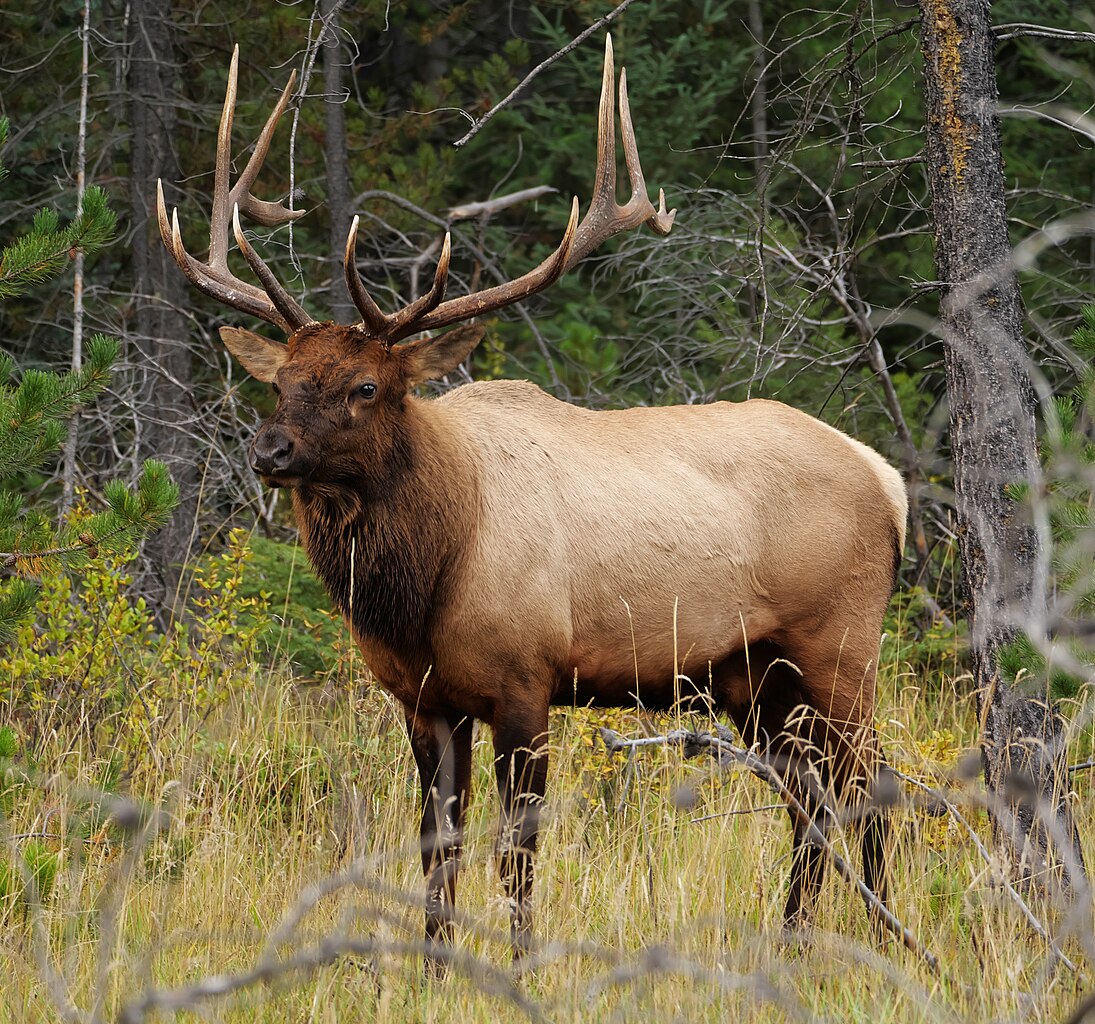
A type of native North American deer, Elks (Cervus canadensis) are large mammals seen in high numbers in the taiga.
Most months of the year are periods when elks are seen in smaller groups. These can be segregated into male and female groups.
During the breeding season, these groups come together, often forming herds of hundreds of elks which makes them a distinct taiga sight.
It’s also during this time that male elks often engage in antler combat. They lose and grow their antlers each year.
Elk are adaptable in terms of diet. They eat grasses, unlike other large deer of the taiga. They also eat tree bark and are known to damage different species of trees.
22. Sitka Black-tailed Deer

Sitka Black-tailed deer (Odocoileus hemionus sitkensis) are types of deer that change their coat colors and are native to Alaska.
This North American species is known to have a reddish color in the summer and brown color in the fall and winter.
A species that migrates, Sitka Black-tailed Deer come down from coniferous forests to mixed forests in the winter.
They feed on grasses and are also known to eat larger amounts of lichen.
In fact, Sitka Black-tailed Deer can eat more food than other mammals as they have 4 stomachs.
Deer of this species can live up to 15 years.
23. Roe Deer

Roe Deer (Capreolus capreolus) is a species of European deer that spread from Scotland to The Caucasus.
These types of deer are prevalent here, with up to a few million living across the continent.
Roe Deer prefer coniferous woodlands as they can hide or retreat here in case of danger.
Some exceptions apply as Roe Deer can rarely live in open agricultural land.
Roe Deer have a limited diet based on grasses and fresh tree shoots. They can also eat fruit from the forest such as various types of berries.
They are also known to favor moist grass eaten soon after it rains.
24. Snow Sheep
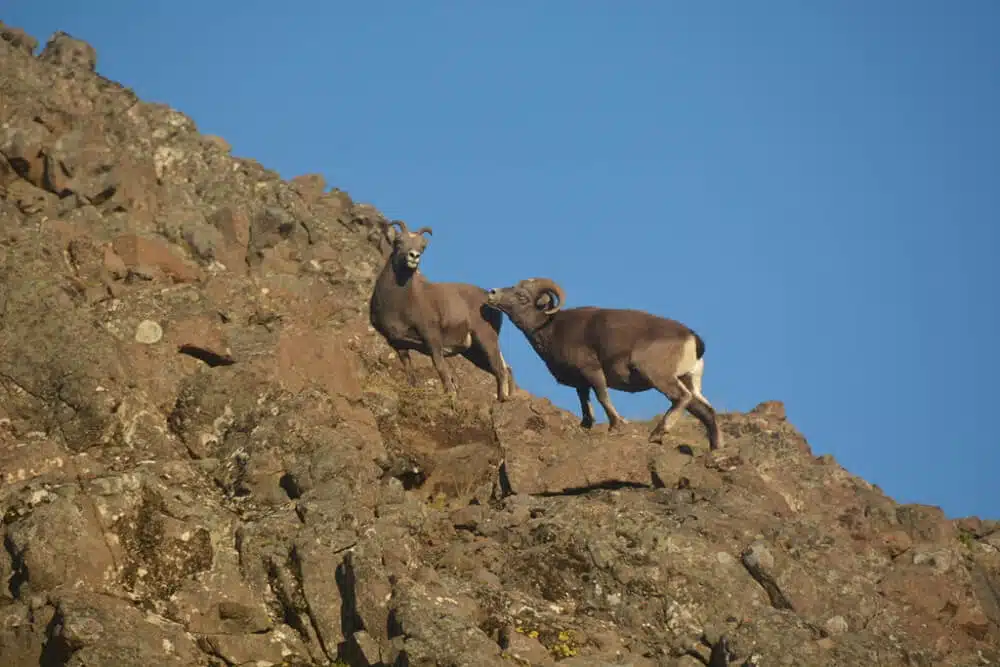
A species of Eastern Siberia, Snow Sheep (Ovis nivicola) is only found in the Russian taiga.
Snow Sheep are adaptable to the steepest and most uneven terrains.
These types of sheep are also aggressive. Males are particularly aggressive towards each other, mostly for breeding rights.
The oldest male is dominant in the group but Snow Sheep are horned, which means they can fight and try to overthrow the dominant male.
It’s typically the males with the largest horns that wing the fights and who get the breeding rights.
All of these fights can take place in almost any environment, including in forests.
Many Snow Sheep can also fight in open areas such as grassland and especially rocky terrains.
25. Wild Boar

One of the most versatile types of mammals, Wild Boars (Sus scrofa) are found in the taiga plus in many other areas of the world.
Swamps and coastal oak forests attract wild boards just as much.
Known for their stocky body and their thin legs, wild boars can be found in different areas of the taiga plus in the steppe.
In addition, wild boars inhabit marshes and forests in these areas but they are also just as common in warmer climates such as in the savanna, alpine forests, temperate forests, and even tropical forests.
While common, they may not be easily found as they sleep all day in a sheltered location and only come out at night.
26. Long-tailed Goral

Long-tailed Gorals (Naemorhedus caudatus) are bovines of remote East Asia regions where they live at high elevations, including in coniferous areas.
Not venturing too far from rocky cliffsides and hills, these types of bovines are mostly interested in living in such terrains as this keeps them safe in front of many predators.
A type of herbivore, Long-tailed Gorals feed on grasses in the short area they live in. They also eat nuts and small fruit.
With a limited number of Long-tailed Gorals left in the wilderness, this is a species that is facing stagnating numbers.
Female Long-tailed Gorals only give birth to only one young which limits their numbers further.
27. Wood Bison

Wood Bison (Bison bison athabascae) are found in areas of The North American Taiga. From Alaska to Canada, these are some of the largest mammals of the taiga.
The species impresses with its large size.
Its shoulders are taller than the rest of its body and can reach a height of over 6 feet. Even more, a wood bison can grow to a length of almost 10 feet.
The sense of smell is also interesting in this species, alongside its size. Wood bison can pick up scents miles away.
While large, wood bison are herbivorous. They eat some of the vegetation they find in the taiga such as grasses and lichens, which are found in high amounts here.
28. Beaver

The Beaver (genus Castor) is one of the most representative mammals of the taiga and of North America.
Beavers are now found in high numbers across North America, believed to be in their millions following a point of near extinction.
Beavers are both detrimental and beneficial to the environment.
They kill trees and vegetation as they use these as materials to create dams. At the same time, these dams create safe spaces for frogs and their eggs as predatory fish can’t reach them.
Beavers are also known to live in families. Male and female partners live together with their offspring.
Kits of the species live with their parents for at least a few months.
29. Squirrel

Squirrels (family Sciuridae) are frugal mammals that thrive in the taiga.
Various species of squirrels can be found here, including The Eurasian Red Squirrel.
There are good reasons for squirrels to live in the taiga, mostly tied to food availability. Squirrels love acorns and they even select their nesting tree based on its number of acorns.
Found across Europe and Asia, The Eurasian Red Squirrel can even have multiple nests in trees.
Some of their favorite nests are maintained for years while their least favorite nests are changed frequently.
They use multiple locations to store acorns but they also have their memorized locations they run to hide in whenever a predator approaches.
A fan of seeds and nuts, the taiga squirrel is mostly solitary and rarely seen in groups.
30. Marmot
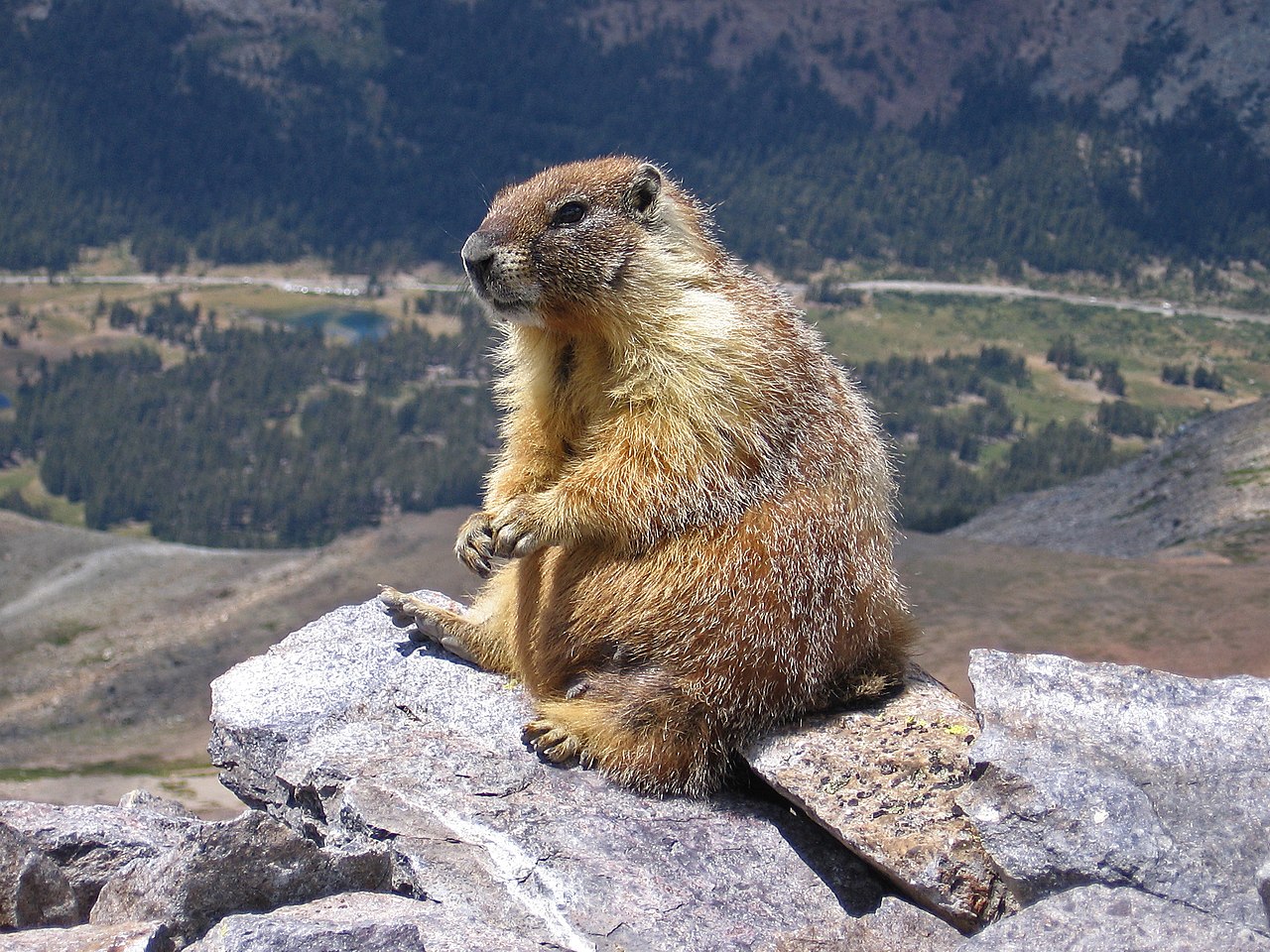
Marmots (genus Marmota) are among the multiple hibernating species of the taiga.
As some of the largest rodents, marmots are some of the most widespread types of animals of the taiga.
They also live in alpine areas, grasslands, and the steppe.
Marmots are found in North America, Europe, and Asian taiga and come in different colors such as yellow and brown.
As the largest rodents, they are also the largest types of hibernating rodents. A typical marmot can vary in length considerably.
It can measure anywhere between 17 and 28 inches with its long tail.
The Siberian taiga is home to multiple types of marmots such as the common Gray Marmot (Marmota baibacina) and the rare Tarbagan marmot (Marmota sibirica).
31. North American Porcupine

North American Porcupines (Erethizon dorsatum) are just slightly smaller than the largest rodent of the North American taiga, the beaver.
Porcupines live in different types of forests spreading from Alaska to Mexico.
Since they like coniferous forests, North American Porcupines are a species of taiga.
North American Porcupines live long lives if they can escape their multiple predators.
These types of rodents are eaten by wolves and bears. If they manage to survive these predators, North American Porcupines can live up to 30 years.
The role of the species in the ecosystem is mixed. They are known to damage trees.
32. Snowshoe Hare

Snowshoe Hares (Lepus americanus) are adaptable to the cool taiga of North America.
This is a species that has large hind legs adapted to walking on snow which also inspires its name.
Snowshoe hares may seem to look different but they actually change coats with the seasons. They become white in the winter for better camouflage but they’re actually brown.
These types of hares feed on the grasses of the taiga in the winter and further adapt their diets in the winter when they are seen nibbling on tree bark.
33. Mountain Hare

From alpine regions to the taiga of Northern Asia and areas of Scandinavia, The Mountain Hare (Lepus timidus) is also a widespread hare.
In some regions, this species may even be referred to as The White Hare, albeit it can be brown in the summer.
A few coat color exceptions apply, especially for Mountain Hares in remote areas which may even turn gray for the winter.
Mountain Hares show different habits depending on the range they live in. These include feeding habits that can be dominated by bark and twig nibbling in snowy areas.
In other areas such as in coastal regions, the hare feeds on short grasses.
34. Canada Lynx

The Canada Lynx (Lynx canadensis) is one of the 4 species of lynxes that lives in the Canadian taiga.
A fierce and quiet predator, The Canada Lynx is also the most common predator of another very common taiga species, The Snowshoe hare.
The inter-dependency of this species is well-established across Canada and Alaska.
Canada’s Lynx populations increase and decrease with Snowshoe hare populations.
As the Snowshoe hare, Canada Lynxes overlap in their range of the boreal forest.
35. Eurasian Lynx
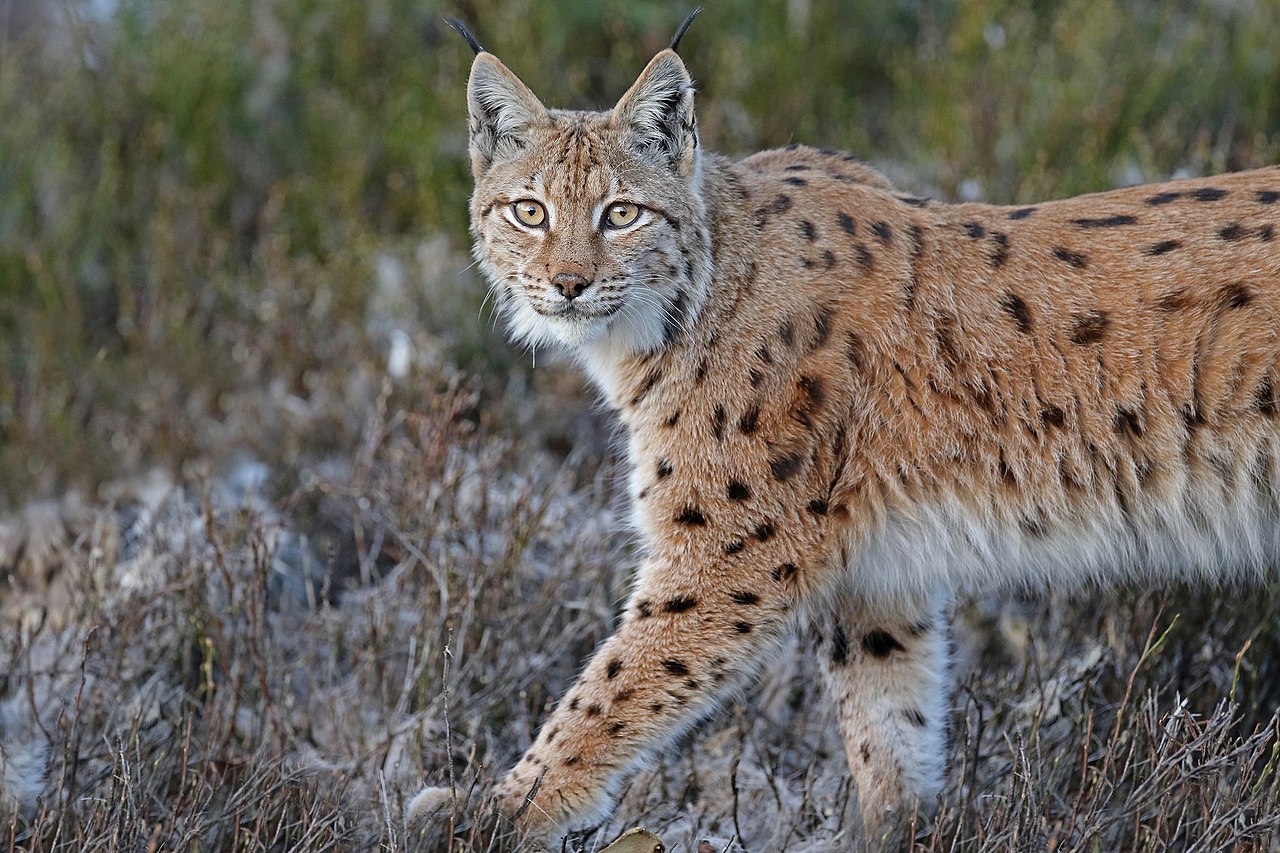
The Eurasian Lynx (Lynx lynx) is the second of the 4 species of lynx that can be found in the taiga (there are 4 types of lynx – Canada lynx, Eurasian lynx, Iberian lynx, and Bobcat).
This almost red type of wildcat is found in different regions of Europe and Asia. It even survives at elevations of up to 18.000 feet.
Eurasian Lynxes in Europe are facing an increase in numbers following periods when they’ve been hunted.
Lynxes are still facing serious predators across their range, particularly in Asia where wolves are known to be their main predator.
As a result, an Eurasian Lynx can spend a lot of time up on trees where wolves can’t reach them.
36. Stoat

Stoats (Mustela erminea) are types of mustelids found in the North American, European, and Asian Taiga.
This is a species that also changes its coat going into the winter.
A brownish color in the summer is adapted to a snow-white color in the winter. This species even thickens its coat for the winter.
As a carnivorous species, stoats feed on small rodents and regularly take on larger types of prey as well.
They can attack voles, hares, and rabbits across their range, often successfully. Water voles are also part of the typical diet of the species in some regions.
37. Siberian Weasel

Highly adaptable to the winters in Siberia, including by coat characteristics from summers to winters.
Siberian Weasels (Mustela sibirica) are a type of burrowing species of The Siberian taiga.
This is a species that only lives in The Siberian Taiga and parts of East Asia such as East China, a place where it survives on a varied diet that starts with water voles.
Feeding on rodents, these types of weasels also eat local reptiles but may resort to plants whenever they cannot find suitable prey.
This species is also known to attack poultry in regions of China.
38. Least Weasel

Least Weasels (Mustela nivalis) live in different habitats, including the taiga or temperate climates on multiple continents.
These weasels have the specific short legs and long necks all weasel species are known for. They also change their coats to white coats in the winter.
Most of their diet is based on small rodents they can easily overpower. Rats aren’t high on their list of priorities.
On the other hand, Least Weasels can also eat different types of large prey such as rabbits.
39. Sable

Mostly found in Russia and only partly in Mongolia and China, Sable (Martes zibellina) is a Siberian-specific species of mammal.
Growing to a length of up to 22 inches, this tree dweller is part of a group of animals that live in coniferous woodlands of the taiga.
The species has been widely re-introduced in its natural habitat in its thousands and can now also be found as far North as there are trees in the taiga.
40. American Marten

The red-brown American Marten (Martes americana) is native to The North American Taiga. It can be found across Canada and Alaska.
Its association with this habitat also prompts its nickname of the Pine Marten.
As a small mammal, American Marten feeds on small rodents and is rarely seen in groups outside of their breeding season.
41. North American River Otter

North American River Otters (Lontra canadensis) are among the mammals that live both in the water and on land in the taiga.
This is a species that hunts for fish and can feed on different types of small fish such as suckers.
They can also eat plants and fruits they find close to water.
North American River Otters are often seen in families with up to 5 offspring.
42. European Otter

European Otters (Lutra lutra) are also known as the Eurasian Otters. They live in a widespread area, including The European and Asian taiga.
Otters of the species are further found in temperate climates and even established in parts of North Africa.
They have a dual-color look with brown dorsal coats and cream-to-white ventral coat coloring.
43. American Mink

American Minks (Neogale Vison) are some of the most common types of minks in Canada’s taiga territories and in The United.
The species is seen as a furry-friendly-looking weasel.
However, it is still a predator, mainly of small rodents. Its long but slender body helps The American Mink drive out rodents from their burrows.
44. Wolverine

Wolverines (Gulo gulo) are some of the most common types of scavengers of the taiga.
Feeding on carrion, wolverines may play a positive role in the taiga biome but often follow other animals for carrion leftovers.
Wolverines often share their taiga habitats with lynxes for they eat whatever is left after their prey is finished.
45. Asian Badger

Asian Badgers (Meles leucurus) are only found in Asia in countries such as Russia, China, Mongolia, and Kazakhstan.
Badgers of this species are also found in The Siberian taiga.
This is a brighter type of badger with bright brown nuances that may also appear tan.
Facial stripes are a distinctive trait of Asian Badgers. Dar brown stripes are visible on its white head.
46. Fisher

Fishers (Pekania pennanti) are found throughout the Canadian boreal forest. This is a species that can climb and is a known predator.
It feeds on Snowshoe hares, animals twice its size.
Fishers have a more diverse diet, on the other hand. They can also eat fruit, but not as commonly as hares or porcupines.
47. Mongolian Wolf

A species found in The East Altai, Mongolian Wolves (Canis lupus chanco) are some of the representative wolves of the taiga.
They live in Mongolia, Russia, and China. A gray coat is specific to these wolves which aren’t the largest as they grow to 37 inches.
This type of wolf comes in contact with human settlements through its hunting of sheep.
48. Coyote

Essentially a smaller type of wolf, the Coyote (Canis latrans) is a species that lives in the tundra where it can be spotted either alone or in groups.
This is a species that even hunts either alone or in a pack.
Small prey such as squirrels is often chased by individual coyotes. Large prey is often the subject of group hunting, similar to how wolves chase and catch large prey.
49. Red Fox

Named after their red coats, Red Foxes (Vulpes vulpes) can sometimes be white or even mostly black.
They are some of the most widespread species of taiga.
With different types of subspecies, The Red Fox is present in boreal forests around the world. An example is the Yakutsk fox, a specific type of Red Fox that lives in The Siberian taiga.
Red foxes are found in North America, Europe, and Asia.
50. Arctic Fox
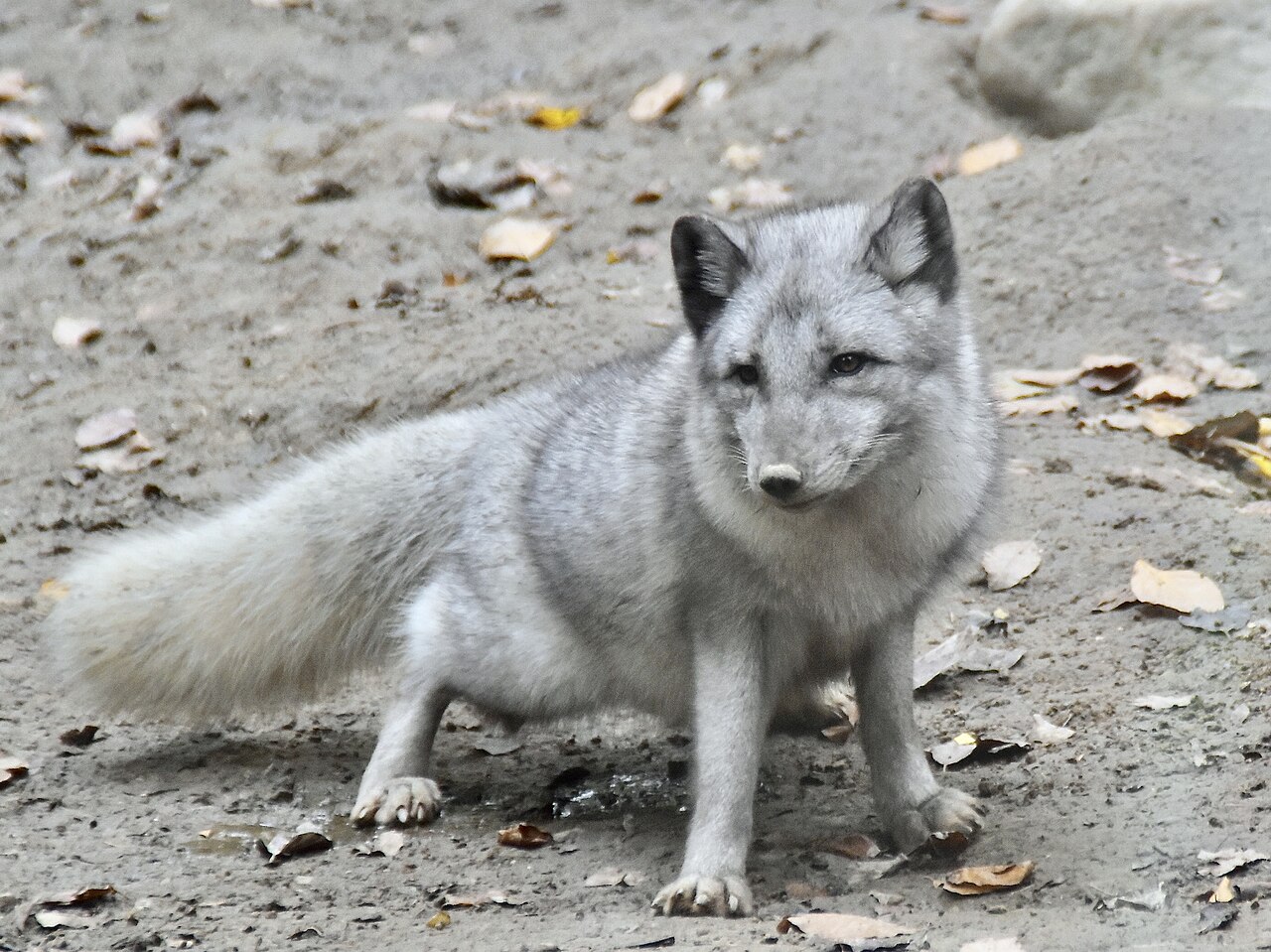
A species of the taiga and tundra, Arctic Foxes (Vulpes lagopus) are identified by their snow-white color.
A species found across the coolest climates in the world, it is also a dominating or sole mammal in some countries, such as Iceland.
The Arctic Fox feeds opportunistically. It can eat birds and their eggs as well as some of the largest fish in its range.
51. American Black Bear

One of the most representative bears of the taiga, The American Black Bear (Ursus americanus) is a dormant species in the winter.
It overwinters in a widespread habitat in Northern Canada as well as in Alaska. The species is also present further South in The United States.
This all-black species is known for its varied diet as well. It eats both bees and their honey and it additionally eats other insects as well as fish.
52. Asiatic Black Bear

A species of the far East in Asia, The Asiatic Black Bear (Ursus thibetanus) is a type of bear found in Easternmost Siberia.
This species also lives in China, Taiwan, and Korea.
Mostly arboreal, The Asiatic Black Bear is specialized in beetles, insects, and other bugs when it comes to its diet. In the absence of such insects, it resorts to grasses and fruit.
53. Siberian Tiger

The Siberian Tiger (Amur tiger) is one of the most representative species of The Siberian Taiga.
This fierce predator is still found in the wilderness in small numbers. While they often travel hundreds of miles, these tigers still live in the most remote areas of the taiga.
Siberian tigers survive here by eating animals such as deer, wild boar, and even smaller Asiatic Black Bears.
54. Amur Leopard

A type of leopard subspecies, The Amur Leopard (Panthera pardus orientalis) is one of the rarest types of mammals of the taiga.
Living in the far East of Siberia, this is a species that is almost extinct. Fewer than 100 Amur Leopards are believed to live in the taiga and in the wilderness today.
Unlike other species of Leopards, The Amur Leopard has a pale coat with black spots.
Fish in The Taiga
The following species of fish are the most representative of the taiga.
55. Alaska Blackfish

One of the oldest species of small fish in Alaska and Siberia, The Alaska Blackfish (Dallia pectoralis) is known as a species natives used to eat.
This is species that lives in swamps with occasional populations across rivers.
Alaska Blackfish eat insects and sometimes other small Alaska Blackfish at times of low food availability.
56. Northern Pike

The Northern Pike (Esox lucius) is another common species of the taiga. The young of this species are even eaten by large Alaska Blackfish.
Lakes of the taiga are among the preferred locations of Northern Pike.
Whichever its water choice is, The Northern Pike is a species that likes to live among thick vegetation as it only grows to 22 inches as opposed to other pike which can reach several feet.
57. Walleye

Often referred to as The Golden Pike or The Yellow Pike, Walleyes (Sander vitreus) are large fish with golden-yellow nuances.
They reach a length of up to 31 inches and have golden lateral coloring while the mid-dorsum is darker olive.
Walleye has also become a popular fishery species given some appreciate its taste despite it being an invasive species in some habitats.
58. Longnose Sucker

A species of The Alaska Taiga, The Longnose Sucker (Catostomus catostomus) is a species named after its atypical and long snout.
Adapted to feeding by sucking, this type of fish has a long snout that is even as long as a third of its total body length.
It can be found in some of the cleanest and coolest streams of Alaska but also in lakes. In both cases, it sits at feeds at the bottom.
59. White Sucker

Highly adaptable to lakes, rivers, and streams, White Suckers (Catostomus commersonii) are also present in the taiga.
While their numbers are smaller here, there are still unexplored territories to fully understand its populations across the boreal forests.
White Suckers are typically associated with lakes of the taiga, but they are prevalent in rivers in temperate climates.
60. Lake Whitefish

A type of fish with a small head, Lake Whitefish (Coregonus clupeaformis) are found in The Canadian Taiga.
This is a species of cool freshwater and can be found in a vast territory from the Northernmost regions of the taiga to The Great Lakes.
Lake Whitefish is also a common species commercially available in stores.
61. Arctic Lamprey
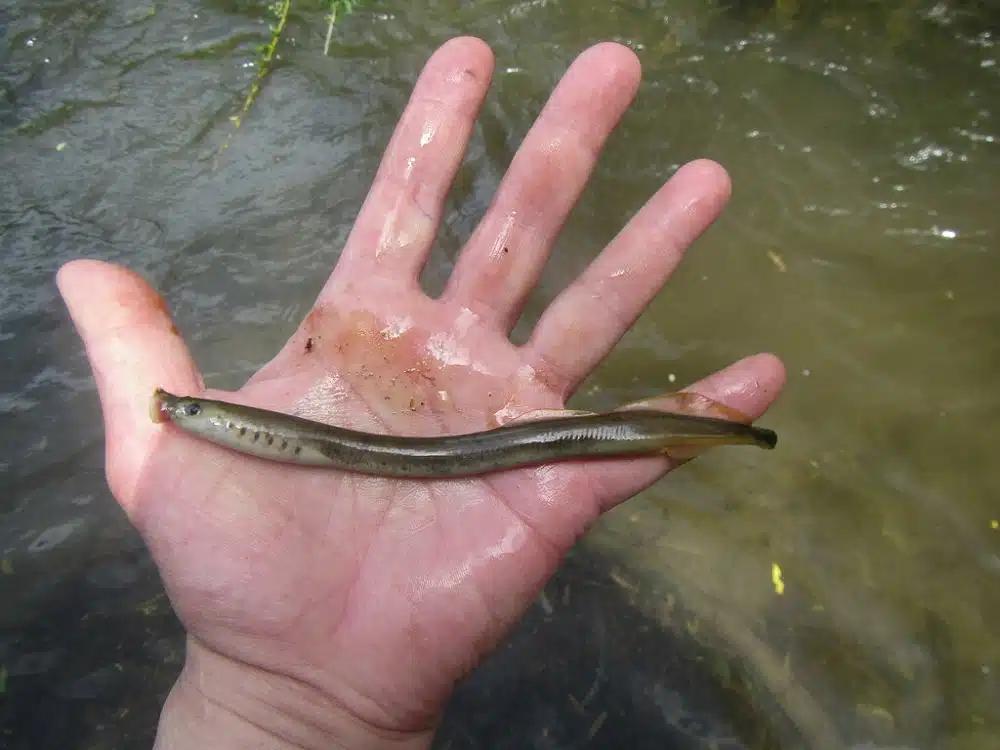
Arctic Lamprey (Lethenteron camtschaticum) is a species of cool water fish that can sometimes migrate.
It inhabits the Siberian taiga as well as sections of Canada and Alaska.
The preferred habitat includes lakes and rivers but the species also lives in dense vegetation coastline.
A typical slender but long Arctic Lamprey reaches a length of around 12 inches but they can be twice as long when older.
62. Brook Trout
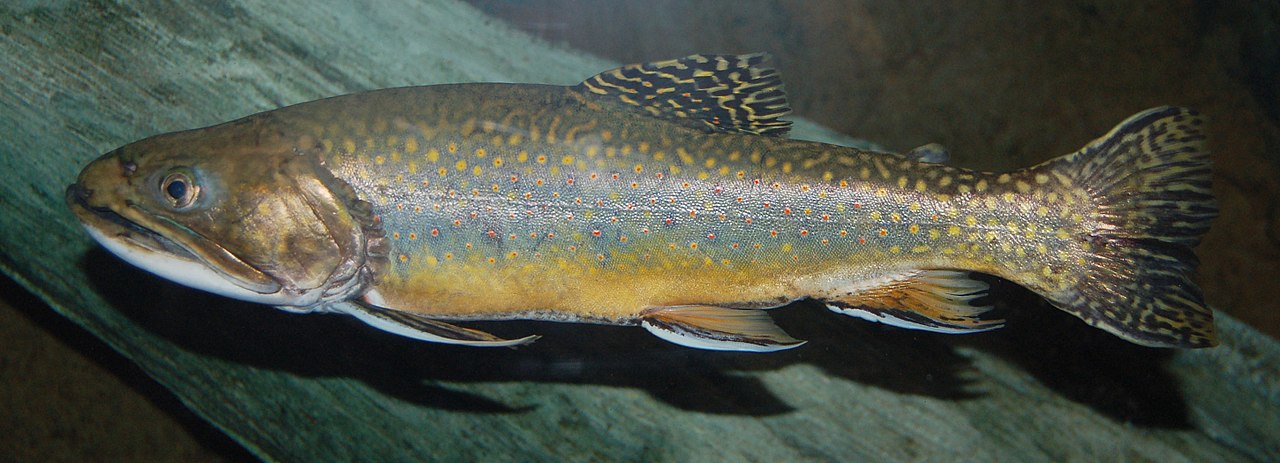
While not as common as in other regions, Brook Trout (Salvelinus fontinalis) is confirmed in the streams of taigas in North America.
This is a species specialized in eating insects and the larvae of insects.
Larger Brook Trouts can also eat frogs and even voles. These fish are native to the taiga and invasive in parts of The United States.
63. Chum Salmon

Chum Salmon (Oncorhynchus keta) can sometimes be found in the rivers of the taiga.
Together with The Atlantic Salmon, Chum Salmon feeds on insects and zooplankton. They are also food for the bears of the taiga.
Chum Salmon, sometimes known as The White Salmon, rarely reaches a length of over 20 inches.
64. Siberian Taimen

The Siberian Taimen (Hucho taimen) can be a few times longer than Chum Salmon, reaching record-breaking lengths of over 70 inches.
Fish of the species are found across Siberia with an extensive range in China and Mongolia.
The fish is considered an excellent game species across the rivers of Siberia.
65. Lake Chub
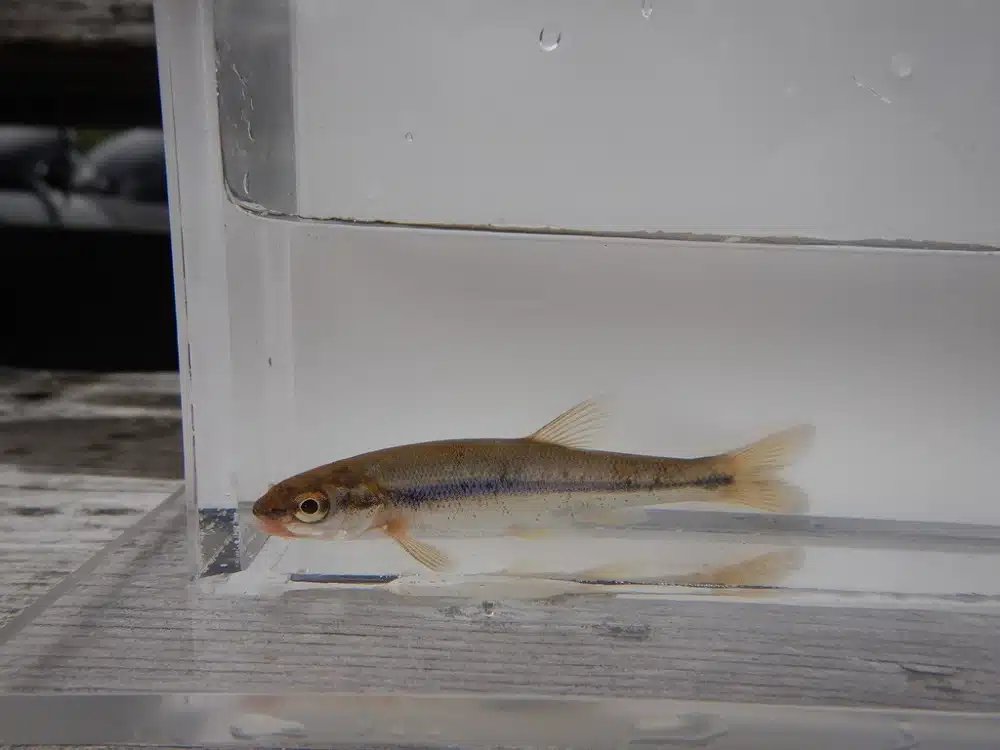
Some of the coldest lakes of Northern Canada in the taiga are home to Lake Chub (Couesius plumbeus).
This is a species that may reach a size of up to 7 inches, at best.
Its habitat in the taiga has also brought its nickname of The Northern Chub, although it migrates for breeding.
Lake Chubs show different habits depending on their region as they can be diurnal in one range and nocturnal in another area.